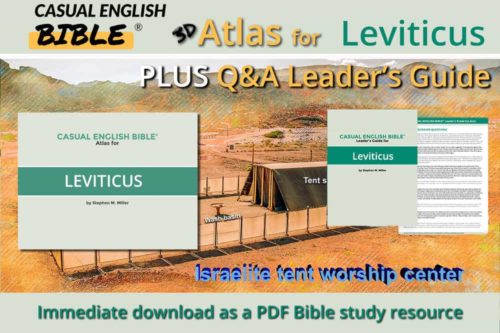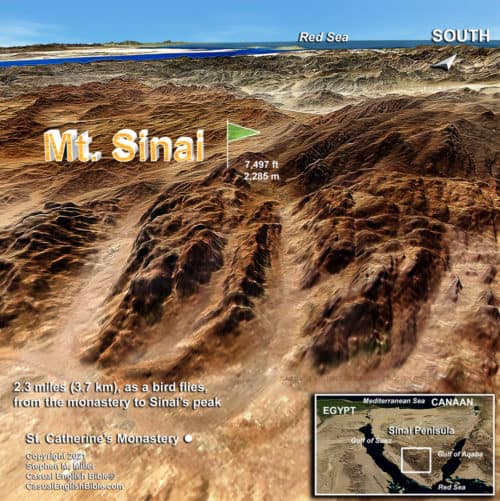Leviticus 7
When it’s time to sacrifice
A priest’s share of guilt offerings
1The LORD continues talking to Moses:I want you to follow these steps when you bring a guilt offering [1] to the Meeting Tent. These are sacred rituals. So do exactly what I tell you.
2Kill the animal you’re sacrificing as a guilt offering, and do it in the same place you kill the animal in a burnt offering. The priest should sprinkle the animal’s blood along the four sides of the altar. 3Then serve up the animal’s fat by burning it on the altar. That includes fat from the internal organs, intestines, and all the fat from the thick tail. [2] 4Add both kidneys along with the fat on them. Include the long lobe of the liver. [3]
5The priest should burn all of this on the altar, as an offering to the LORD—a guilt offering. 6Any male priest may eat the priests’ share of the sacrifice. [4] But it has to be eaten in a sacred place [5] because the meat of the sacrifice is sacred. 7When you bring a guilt offering to the LORD, do it the same way you bring a sin offering. Follow the same how-to steps. The officiating priest gets the priests’ share of the meat. 8In a burnt offering, the officiating priest also gets to keep the animal’s hide. [6]
Priests’ share of grain
9In every grain offering [7] presented as something baked, or cooked in a pot, or fried on a skillet, the officiating priest gets to keep the priests’ share. 10But every grain offering of flour—mixed with oil or not—goes to the priests. They should share it equally among themselves.How to present a peace offering
11I also want you to know how to bring different kinds of peace offerings [8] to the LORD. 12If you’re bringing this offering as a way of saying thank you, then bring side dishes of yeast-free bread made from fine flour and olive oil. 13So, bring the sacrifice with the bread.14If you make different kinds of grain products, [9] give the priest one of each kind. He’ll keep the bread for himself. And he’ll officiate at the ritual by splashing the sacrificed animal’s blood on the sides of the altar. 15Eat the meat from a thanksgiving sacrifice the day it’s offered. Make sure there are no meat leftovers. [10] Don’t leave any of it overnight. 16But that’s not the case with a peace offering that’s simply an expression of your devotion to the LORD, or if it has to do with a voluntary promise you made to the LORD. In those cases, you each save leftovers to eat the next day. 17If there’s any leftover meat on the third day, burn it.
18If you’re disgusting enough to eat three-day-old meat, you’ll ruin the offering. It will be as though it never happened. And you’ll suffer the consequences. 19If the sacrificial meat comes into contact with anything ritually unclean, don’t eat it. Burn it. As for the good meat, you can serve it to anyone who is ritually clean and not contaminated by anything known to be unclean. [11] 20If you’re ritually unclean and you eat meat from a peace offering, you’re no Israelite. [12] 21I’ll say it again. If you eat any meat from a peace offering to the LORD after you’ve touched something unclean—whether human or animal or anything forbidden—you’re no Israelite.
Eat your meat well done
22The LORD told Moses: 23Tell this to the people of Israel: Don’t eat fat from cattle, sheep, or goats.24You can use the fat of a dead animal in other ways. But don’t eat it. This includes animals that die on their own or are killed by wild animals. 25And don’t eat fat from an animal sacrificed to the LORD. If you do that, you’re no Israelite.
26And don’t drink blood or eat meat with blood in it. Not from a bird. Not from any other animal you have. 27If you eat anything with blood in it, you’re no Israelite.
Priests get part of peace offerings
28The LORD told Moses: 29Tell this to the people of Israel: When you bring a peace offering to the LORD, give the LORD a share of the meat from the sacrificed animal. 30Give the LORD the animal’s fat along with meat from the breast. The breast meat will become an offering of gratitude. [13] 31The priest will burn the fat in a sacrifice that goes up in smoke. But he’ll keep the breast meat for Aaron and his sons to share.32You should also give the officiating priest the right thigh, as an offering to him alone. 33The right thigh goes to the priest who did the work of burning the fat on the altar. 34From now on, I want the breast and the right thigh of any peace offering to go to Aaron and his sons. 35This is the share of the peace offerings that go to Aaron and his sons once they become priests. 36This is the same offering the Israelites brought to God when Aaron and his sons became priests. [14] This share of meat God assigned to priests is permanent. Future priests get this meat, too.
37So, these are the laws about the burnt offering, grain offering, sin offering, guilt offering, ordination offering, and peace offering. 38The LORD gave these laws to Moses at Mount Sinai. Then he told the people of Israel to start bringing their offerings to the LORD there in the badlands of the Sinai Peninsula.
Footnotes
In older lingo, the guilt offering was called the trespass offering, as in, “Forgive us our trespasses” or sins. In fact, scholars can’t seem to figure out what the difference is between a “sin offering” and a “guilt offering.” The steps are identical (7:7). One guess is that guilt offerings are for more serious offenses and often involve making restitution. Leviticus 5:14-7:7 talks about when a person needs to make a guilt offering. Leviticus 7:1-10 talks about how to make the sacrifice.
Herders bred fat-tailed sheep in and around what is now Israel and Palestinian Territory. The tail of a mature ram could weigh 20 pounds (9 kg) or more. Fat on the tail was considered the tastiest meat a sheep had to offer.
Literally, “finger of the liver.” It’s usually identified as the caudate lobe. There are three other lobes: right, left, and quadrate.
Apparently the priest officiating at the sacrifice would receive the priests’ share of the meat and then invite other priests to help eat the meat.
Priests eat in the courtyard of the tent worship center, sometimes called the Meeting Tent (Leviticus 6:26).
This is a bit of new information to the burnt offering instructions in 1:3-13 and 6:1-6.
For more about grain offerings see Leviticus 2:1-3; 6:14-18.
A peace offering, also described in Leviticus 3, is one of several prescribed offerings in Jewish tradition. When Jewish people wanted to thank God for something, such as good health or safety, they would sacrifice a sheep, goat, cow, or bull. They would burn part of the animal, including the kidneys and fat covering the intestines. They would eat the rest in celebration, often with family and friends. It takes a fair number of hungry people to eat a cow. But people were eager to eat meat because it was rare in Bible times for common folks to eat meat, many Bible scholars say.
People could bring various products made of grain, such as bread, cakes, and wafers.
Only a token of the meat is sacrificed on the altar. Most is eaten as a celebration by the worshiper, with family and friends.
Israelites were ritually unclean, for example, if they touched a corpse and hadn’t gone through the cleaning rituals, which included washing themselves. A woman in her monthly period was considered unclean. For more, see Leviticus 15.
More literally, the person “should be removed from the community” or “cut off.” This is a consequence repeated throughout these early books of the Bible. It’s unclear how and by whom the offenders were removed. Perhaps they could no longer worship at the tent worship center, or they lost their rights as citizens of this emerging nation that Moses seemed to be organizing. Maybe they were executed. Or perhaps the community let God deal with the person. Scholars seem uncertain about what happened.
This sacrificial offering goes by various names: fellowship offering, elevation offering, symbolic offering, special offering, and wave offering. The Hebrew word can mean to wave, lift, or blow. In Exodus 29, this sacrifice represented the culmination of an ordination service authorizing priests for ministry. It was the final act, which some scholars say was mainly an expression of gratitude to God for allowing these men to be assigned to lead the worship rituals for the people of Israel.
Exodus 29:24.
Discussion Questions
- 1
ROBERT V. HUBER
There’s a lot said in Leviticus about giving the priests their share of the sacrifices being made. What passages in the New Testament and what practices in your own church seem to be extensions of these demands to support the clergy?’’
- 2
Not only are the priests due some of the sacrificed meat to eat, for some sin offerings they are also rewarded the hide of the slaughtered animal. Why would they want that?
- 3
Peace offerings had been discussed in Leviticus 3, but they pop up again here in more detail. There are three different types of peace offerings listed in verses 12 and 16: a thank you, a freewill offering, and an offering related to a promise made to God. Do you think people today continue a modern version of those same practices? Or are we missing out on opportunities to connect to God?
- 4
Moses tells the people that they are permitted to eat the leftovers of meat from a peace offering that is an expression of devotion to the LORD, or if it has to do with a voluntary promise made to the LORD. But they can only do so the next day. On the third day they should burn everything. Why do you think a time limit is set here?
- 5
LIFE APPLICATION: Chapter 7 ends with a summary statement: “The LORD gave these laws to Moses at Mount Sinai. Then he told the people of Israel to start bringing their offerings to the LORD there in the badlands of the Sinai Peninsula.” We’re not about to butcher animals and burn their bodies to honor God and ask favors of him. But there are other things we can do. What kinds of things do you think some Christians and perhaps Jewish people do on a regular basis that might be in the spirit of these ancient sacrifices?







